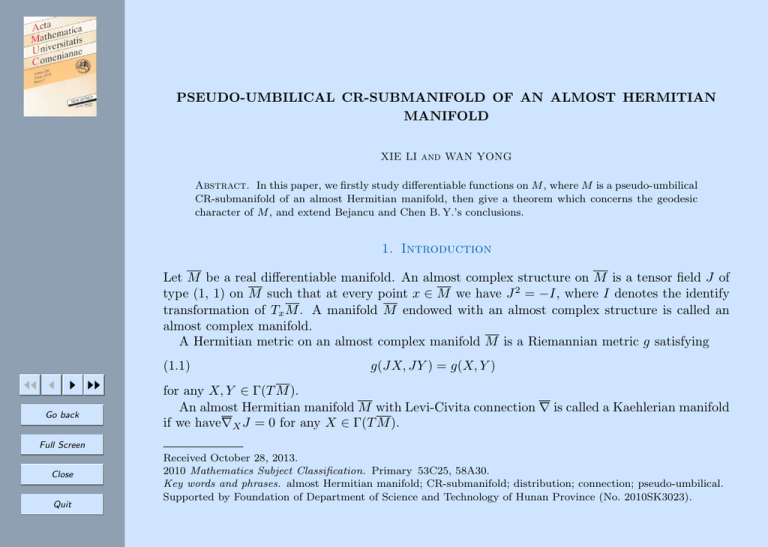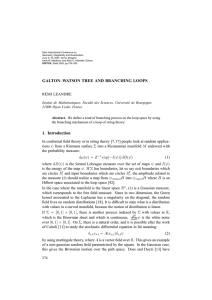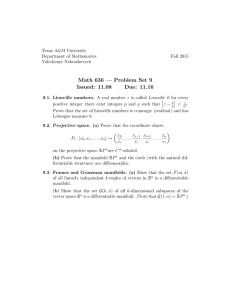PSEUDO-UMBILICAL CR-SUBMANIFOLD OF AN ALMOST HERMITIAN MANIFOLD
advertisement

PSEUDO-UMBILICAL CR-SUBMANIFOLD OF AN ALMOST HERMITIAN
MANIFOLD
XIE LI and WAN YONG
Abstract. In this paper, we firstly study differentiable functions on M , where M is a pseudo-umbilical
CR-submanifold of an almost Hermitian manifold, then give a theorem which concerns the geodesic
character of M , and extend Bejancu and Chen B. Y.’s conclusions.
1. Introduction
Let M be a real differentiable manifold. An almost complex structure on M is a tensor field J of
type (1, 1) on M such that at every point x ∈ M we have J 2 = −I, where I denotes the identify
transformation of Tx M . A manifold M endowed with an almost complex structure is called an
almost complex manifold.
A Hermitian metric on an almost complex manifold M is a Riemannian metric g satisfying
(1.1)
JJ J
I II
Go back
g(JX, JY ) = g(X, Y )
for any X, Y ∈ Γ(T M ).
An almost Hermitian manifold M with Levi-Civita connection ∇ is called a Kaehlerian manifold
if we have∇X J = 0 for any X ∈ Γ(T M ).
Full Screen
Close
Quit
Received October 28, 2013.
2010 Mathematics Subject Classification. Primary 53C25, 58A30.
Key words and phrases. almost Hermitian manifold; CR-submanifold; distribution; connection; pseudo-umbilical.
Supported by Foundation of Department of Science and Technology of Hunan Province (No. 2010SK3023).
Let M be an m-dimensional Riemannian submanifold of an n-dimensional Riemannian manifold
M . We denote by T M ⊥ the normal bundle to M and by g both metric on M and M . Also, by
∇ we denote the Levi-Civita connection on M , by ∇ denote the induced connection on M , by ∇⊥
and denote the induced normal connection on M .
Then, for any X, Y ∈ Γ(T M ), we have
(1.2)
∇X Y = ∇X Y + h(X, Y ),
where h : Γ(T M ) × Γ(T M ) → Γ(T M ⊥ ) is a normal bundle valued symmetric bilinear form on
Γ(T M ). The equation (1.2) is called the Gauss formula and h is called the second fundamental
form of M .
Now, for any X ∈ Γ(T M ) and V ∈ Γ(T M ⊥ ) by −AV X and ∇⊥
X V we denote the tangent part
and normal part of ∇X V , respectively. Then we have
(1.3)
∇X V = −AV X + ∇⊥
X V.
Thus, for any V ∈ Γ(T M ⊥ ), we have a linear operator, satisfying
(1.4)
g(AV X, Y ) = g(X, AV Y ) = g(h(X, Y ), V ).
The equation (1.3) is called the Weingarten formula.
JJ J
I II
Go back
Full Screen
Close
Quit
Definition 1.1 ([1]). Let M be a real n-dimensional almost Hermitian manifold with almost
complex structure J and with Hermitian metric g. Let M be a real m-dimensional Riemannian
manifold isometrically immersed in M . Then M is called a CR-submanifold of M if there exists a
differentiable distribution D : x → Dx ⊂ Tx M , on M satisfying the following conditions:
(1) D is holomorphic, that is, J(Dx ) = Dx for each x ∈ M ,
(2) the complementary orthogonal distribution D⊥ : x → Dx⊥ ⊂ Tx M ,
is anti-invariant, that is, J(Dx⊥ ) ⊂ Tx M ⊥ for each x ∈ M .
Let M be a CR-submanifold of an almost Hermitian manifold M , then we have the orthogonal
decomposition
T M ⊥ = JD⊥ ⊕ ν.
(1.5)
By r denote the complex dimension of νx (x ∈ M ), Since ν is a holomorphic vector bundle, we can
take a local field of orthonormal frames on T M ⊥
{JE1 , JE2 , · · · , JEq , V1 , V2 , · · · , Vr , Vr+1 = JV1 , Vr+2 = JV2 , · · · , V2r = JVr }
where {E1 , E2 , · · · , Eq } is a local field of orthonormal frames on D⊥ . Then we let
Ai = AJEi ,
Aα = AVα ,
Aα∗ = AVα∗ ,
where
i, j, k, · · · = 1, · · · , q; α, β, γ, · · · = 1, · · · , r; α∗ , β ∗ , γ ∗ · · · = r + 1, · · · , 2r.
Definition 1.2 ([1]). The CR-submanifold M is said to be pseudo-umbilical if the fundamental
tensors of Weingarten are given by
JJ J
I II
Go back
(1.6)
Ai X = ai X + bi g(X, Ei )Ei ,
(1.7)
Aα X = aα X +
biα g(X, Ei )Ei ,
i=1
q
X
Full Screen
(1.8)
Aα∗ X = aα∗ X +
biα∗ g(X, Ei )Ei ,
i=1
Close
Quit
q
X
where
ai , bi , aα , aα∗ , biα , biα∗
are differential functions on M and X ∈ Γ(T M ).
Now let M be an arbitrary Riemannian manifold isometrically immersed in an almost Hermitian
manifold M . For each vector field X tangent to M , we put
(1.9)
JX = φX + ωX,
where φX and ωX are the tangent part and the normal part of JX, respectively. Also, for each
vector field V normal to M , we put
(1.10)
JV = BV + CV,
where BV and CV are the tangent part and the normal part of JV , respectively.
The covariant derivative of B, C, respectively, is defined by
(1.11)
⊥
(∇X B)V = ∇⊥
X BV − B∇X V,
(1.12)
⊥
(∇X C)V = ∇⊥
X CV − C∇X V
for all X ∈ Γ(T M ), V ∈ Γ(T M ⊥ ).
A CR-submanifold M of an almost Hermitian manifold M is D-geodesic if we have
JJ J
I II
(1.13)
h(X, Y ) = 0
Go back
for any X, Y ∈ Γ(D). M is mixed geodesic if we have
Full Screen
Close
Quit
(1.14)
for any X ∈ Γ(D) and Y ∈ Γ(D⊥ ).
h(X, Y ) = 0
2. Main Results
Theorem 2.1 ([1]). Let M be a CR-submanifold of an almost Hermitian manifold M , then M
is mixed geodesic if and only if
AV U ∈ Γ(D⊥ )
AV X ∈ Γ(D),
for each X ∈ Γ(D), U ∈ Γ(D⊥ ), V ∈ Γ(T M ).
Theorem 2.2. Let M be a pseudo-umbilical CR-submanifold of an almost Hermitian manifold
M , then M is mixed geodesic.
Proof. For each X ∈ Γ(D), Y ∈ Γ(D⊥ ), according to the Definition 1.2 we get
Ai X = ai X ∈ Γ(D),
and
Aα X = aα X ∈ Γ(D),
Ai Y = ai Y + bi g(Y, Ei )Ei ∈ Γ(D⊥ ),
Aα Y = aα Y +
JJ J
I II
Quit
biα g(Y, Ei )Ei ∈ Γ(D⊥ ),
Aα∗ Y = aα∗ Y +
biα∗ g(Y, Ei )Ei ∈ Γ(D⊥ ).
i=1
The assertion follows from Theorem 2.1.
Close
q
X
i=1
q
X
Go back
Full Screen
Aα∗ X = aα∗ X ∈ Γ(D)
Since a Kaehlerian manifold is an almost Hermitian manifold, we obtain the following corollary.
Corollary 2.1 ([1]). Any pseudo-umbilical CR-submanifold of a Kaehlerian manifold is mixed
geodesic.
Lemma 2.1. Let M be a pseudo-umbilical CR-submanifold of an almost Hermitian manifold
M , then
(2.1)
g(AJV X − JAV X + (∇X J)V, Z) = 0
for all X, Z ∈ Γ(D), V ∈ Γ(ν).
Proof. Let X, Z ∈ Γ(D), V ∈ Γ(ν). From Weingarten formula and (1.1), we get
g(AJV X − JAV X, Z) = g(−∇X JV, Z) + g(AV X, JZ)
= −g(∇X JV, Z) + g(J∇X V, Z)
(2.2)
= −g((∇X J)V, Z).
The proof is now complete from (2.2).
Lemma 2.2. Let M be a CR-submanifold of an almost Hermitian manifold M . Then we have
(2.3)
JJ J
I II
(∇X B)V = ∇X BV − B∇⊥
XV
= ACV X − φAV X + ((∇X J)V )>
for all X ∈ Γ(T M ), V ∈ Γ(T M ⊥ ).
Proof. Let X ∈ Γ(T M ), V ∈ Γ(T M ⊥ ). From (1.10) and Weingarten formula, we obtain
Go back
Full Screen
Close
Quit
(2.4)
(∇X J)V = ∇X JV − J∇X
= ∇X (BV + CV ) + J(AV X − ∇⊥
X V ).
By using the Gauss formula, we get
(2.5)
∇X (BV + CV ) = ∇X BV + h(X, BV ) − ACV X + ∇⊥
X CV.
Taking account of (1.9) and (1.10), we have
(2.6)
⊥
⊥
J(AV X − ∇⊥
X V ) = φAV X + ωAV X − B∇X V − C∇X V.
From (2.5), (2.6), (1.11) and (1.12), (2.4) can become
(2.7)
(∇X J)V = (∇X B)V + h(X, BV ) − ACV X
+ (∇⊥
X C)V + φAV X + ωAV X
By comparing to the tangent part in (2.7), (2.3) is satisfied.
Theorem 2.3. Let M be a pseudo-umbilical proper CR-submanifold of an almost Hermitian
manifold M . If q > 1, then we have Aj Ei = Aα X = Aα∗ X = 0 for all X ∈ Γ(D), i 6= j.
Proof. From (1.4) and (1.6), we obtain
g(AJEj Ej , Ei ) = g(AJEj Ei , Ej ) = 0,
JJ J
I II
thus AJEj Ei ∈ Γ(D). On the other hand, AJEj Ei = aj Ei + bj g(Ei , Ej )Ej = aj Ei ∈ Γ(D⊥ ), hence
Aj Ei = 0.
For a unit vector X ∈ Γ(D),by using (1.7), (1.1), (2.1) and (1.8) we have
(2.8)
Go back
= g(Aα∗ X + (∇X J)Vα , JX)
= g(aα∗ X + (∇X J)Vα , JX)
Full Screen
= aα∗ g(X, JX) + g((∇X J)Vα , JX)
Close
(2.9)
Quit
aα = g(aα X, X) = g(Aα X, X)
= g(((∇X J)Vα )> , JX).
Taking (2.3) into account, (2.9) can become
(2.10)
aα = g(−ACVα X + φAVα X, JX)
= g(−Aα∗ X, JX) + g(Aα X, X).
From (2.8) and (2.10), we have
(2.11)
g(−Aα∗ X, JX) = 0,
thus Aα∗ X ∈ Γ(D⊥ ). On the other hand, Aα∗ X = aα∗ X +
hence Aα∗ X = 0.
In a similar way we get Aα X = 0.
Pq
i
i=1 bα∗ g(X, Ei )Ei
= aα∗ X ∈ Γ(D),
For Ei ∈ Γ(D⊥ ) and a unit vector field X ∈ Γ(D), from ai = g(Ai Ej , Ej ), aα∗ = g(Aα∗ X, X)
and (2.8), according to the Theorem 2.3, we have the following theorem.
JJ J
I II
Theorem 2.4. Let M be a pseudo-umbilical proper CR-submanifold of an almost Hermitian
manifold M . If q > 1, then aj = aα = aα∗ = 0.
Since a Kaehlerian manifold is an almost Hermitian manifold, we obtain
Go back
Full Screen
Close
Quit
Corollary 2.2 ([1]). Let M be a pseudo-umbilical proper CR-submanifold of a Kaehlerian
manifold M . If q > 1, then the functions aj , aα , aα∗ vanish identically on M .
Theorem 2.5. Let M be a pseudo-umbilical proper CR-submanifold of an almost Hermitian
manifold M . If q > 1, then M is D-geodesic.
Proof. Taking account of Definition 1.2 and Theorem 2.4, we get
g(h(X, Y ),
q
X
JEi +
(2.12)
=
q
X
i=1
q
X
2r
X
Vα +
g(AJEi X, Y ) +
r
X
g(AVα X, Y ) +
bi g(X, Ei )g(Y, Ei ) +
2r
X
g(Aα∗ X, Y )
α∗ =r+1
α=1
q
r X
X
biα g(X, Ei )g(Y, Ei )
α=1 i=1
i=1
+
Vα∗ )
α∗ =r+1
α=1
i=1
=
r
X
q
2r
X
X
biα∗ g(X, Ei )g(Y, Ei )
α∗ =r+1 i=1
for all X, Y ∈ Γ(D). From (2.12), we have
JJ J
I II
g(h(X, Y ),
q
X
i=1
Go back
so h(X, Y ) = 0, i.e., M is D-geodesic.
JEi +
r
X
α=1
Vα +
2r
X
Vα∗ ) = 0,
α∗ =r+1
Full Screen
Close
Quit
1. Bejancu A., Geometry of CR-submanifolds, Reide Publishing Company, USA 1985, 1–29.
2. Okumura M., Submanifolds of a Kaehlerian manifold and a Sasakian manifold, Lecture Notes, Michigan State
Univ. 1971, 217–234.
3. Wan Yong and Donghe Pei, Integrability of distribution D⊥ on a nearly Sasakian manifold, Acta Math. Acad.
Paedagog. Nyhazi 25 (2009), 271–276.
4. Wan Yong, Integrability of distribution D ⊕ {ξ} on a nearly Sasakian manifold, Journal of Changsha Univ. of
Science and Technology(NS) 4 (2007), 72–74.
5. Wan Yong and Gao Qiju, Integrability of distribution on a CR-submanifold of a quasi Kaehlerian manifold,
Journal of Changsha Univ. of Electric Power(NS) 13 (1998), 7–15.
6. Chen B. Y., CR-submanifolds of a Kaehlerian manifold, Differential Geometry 16 (1981), 305–323.
, Totally umbilical submanifolds of Kaehler manifolds, Archiv der Mathematik 36 (1981), 83–91.
7.
Xie Li, Dept.of Math.and Computing Science, Changsha University of Science and Technology, Changsha, Hunan,
P. R. China, e-mail: lily xieli@163.com
Wan Yong, Dept.of Math.and Computing Science, Changsha University of Science and Technology, Changsha,
Hunan, P. R. China, e-mail: wanyong870901@foxmail.com
JJ J
I II
Go back
Full Screen
Close
Quit





